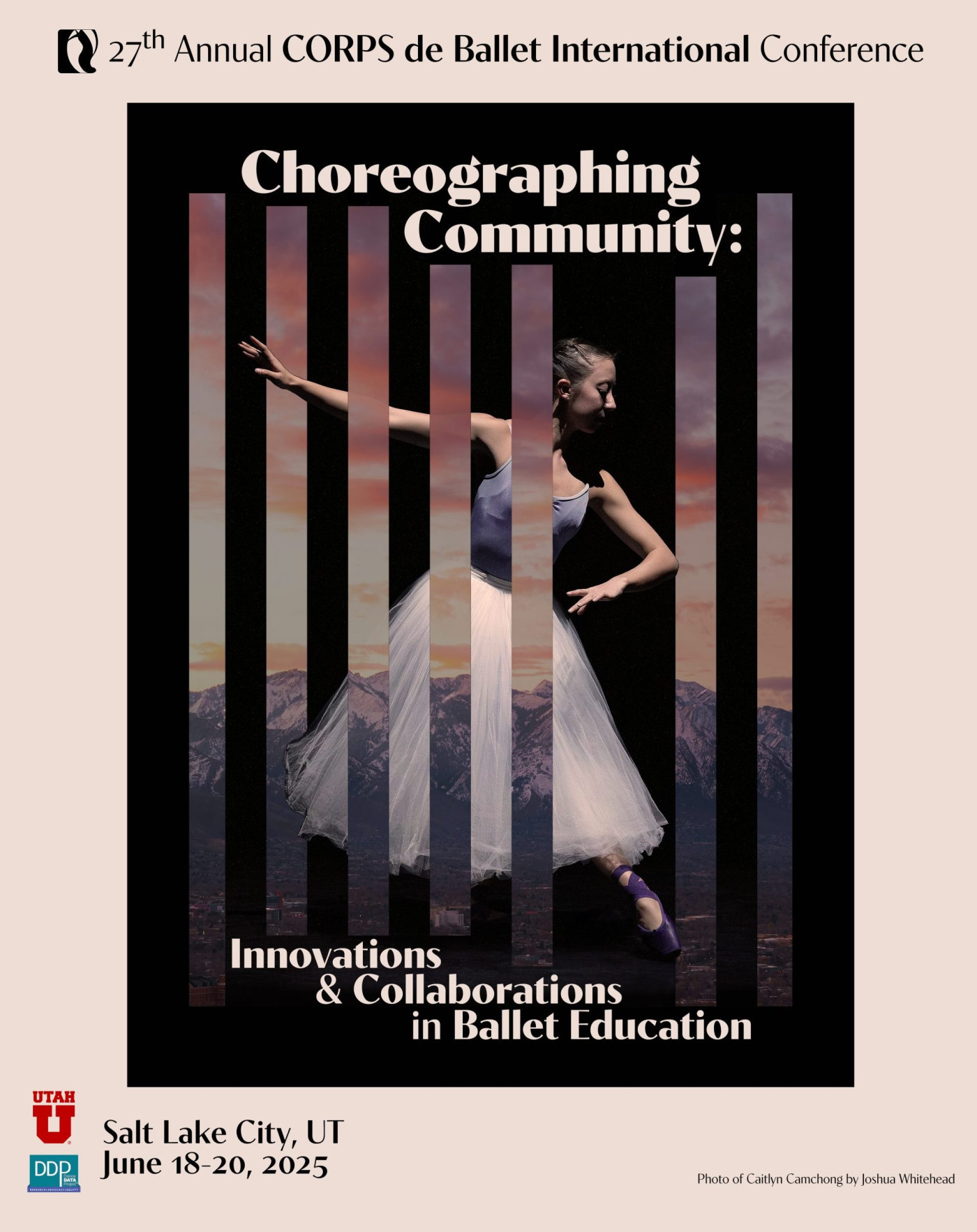The School of Dance will host the 27th Annual CORPS de Ballet International Conference on the U campus from 6/18–20. CORPS is the only academic organization with a mission focused on ballet in higher education.
School of Dance Director, Melonie B. Murray (Dance), currently serves as president of the organization, and many School of Dance alumni, faculty, and staff are involved in this year's conference – including board members Associate Professor Joselli Deans (Dance) and alum Tyler Schnese (Ballet MFA ‘23). Additional alumni, faculty, and staff involved in the conference include: peer-reviewed presenters Colleen Barnes (Ballet MFA ‘17), Emma Capen (Ballet MFA ‘25), Julia Gleich (Ballet MFA ‘94, DAA ‘14), Rebekah Joann Guerra (Ballet MFA ‘24), Jamie Johnson (Ballet BFA ‘03, English BA ‘03), Thea van Warmerdam Patterson (Ballet MFA ‘23), Justine Sheedy-Kramer (Dance), guest panelists Karina Biancone (Ballet BFA ‘17), Allison DeBona (Dance), Michaela Gerard (Ballet BFA ‘16, Psychology BS ‘16), Sierra Govett (Ballet BFA ‘18, Environmental Studies BS ‘18), Sarah Rinderknecht (Ballet BFA ‘23, Accounting BS ‘23, Entrepreneurship Minor ‘23), Stacie Brown Riskin (Ballet BFA ‘14), Carly Schaub (Modern MFA ‘15), Ashley Jian Thomson (Ballet BFA ‘18, Communications BS ‘18), and Rex Tilton (Dance); and conference planning committee members Christine McMillan (Dance), and Yvonne Racz (English BA ‘89).
Click the tabs below to view the presentation abstracts.
Character Dance as a Bridge Between Ballet and a Global Dance Community
Justine Sheedy-Kramer, Adjunct Associate Professor, University of Utah
Abstract: The layers of global dance are complex: these can include folk, ethnic, national, spiritual, and vernacular dance forms. With broad dissemination and blurred lines of these forms developing in the 21st century, it is essential to approach the representation of cultures with authenticity and respect. Character dance has the unique position of presenting global dance perspectives in a ballet lens, while also utilizing balletic elements within the study of global dance perspectives. Just as ballet has clear technical constructs for the patterning of movement, character dance offers clarity in the codification of global dance forms.
From the establishment of classical ballet repertoire in the 19th century to the development of character dance pedagogy in the 20th century, transformations in technology, transportation, politics, culture, and society have impacted the accessibility, communication, and veracity of global dance forms in the 21st century. This paper seeks to analyze three primary pathways on this bridge: How does character dance support classical ballet training in the 21st century? How could character dance serve as a foundation for cross-cultural communication and community engagement with ballet? How can character dance be utilized more effectively and authentically by choreographers, restagers, and repetiteurs? These pedagogical, cultural, social, and artistic considerations may offer the opportunity to redefine ballet's broad community connections. My research explores practical solutions and possible applications, along with pitfalls and challenges, to develop a framework for reconnection, restoration, and collaboration between classical ballet repertoire and global dance forms.
Ballet Across Communities: Socio-Cultural Comparisons and Institutional Practices in Higher Education
Colleen Barnes, Assistant Professor, University of Akron; Ilana Goldman, Associate Professor, Florida State University; Jamie Johnson, Associate Professor, Utah Valley University; Christa St. John, Assistant Professor, Utah Valley University
Abstract: This panel discussion explores the complex interplay between socio-cultural factors and ballet practices in higher education. Bringing together influential ballet educators from a range of higher education dance programs, the panel examines how ballet is situated within their respective communities, focusing on the intersection of local demographics, cultural expectations, and institutional structures. The conversation highlights how societal shifts are currently shaping ballet training and practice in academic settings. Panelists delve into regional and cultural differences that influence both pedagogy and performance, offering insights into how these factors either challenge or reinforce traditional norms within ballet. The discussion analyzes how existing structures within academic spaces can be adapted and reimagined to develop ballet communities. By exploring the cross-commonalities and divergent experiences arising from these sociocultural influences, the panel investigates how local, regional, and national factors converge to shape the lived experiences of ballet practitioners. Through this dialogue, the panel seeks to explore best practices amongst university professors to support communitybuilding and foster excellence in ballet education.
Integrating Afrocentric Principles and Gaga Methodologies in Ballet Education
Rebekah Joann Guerra, Adiunct Professor, Weber State University
Abstract: This proposal emphasizes a feminist perspective and critical pedagogy in integrating Afrocentric principles and Gaga methodologies into contemporary ballet education. The central thesis posits that reimagining ballet pedagogy through these frameworks can liberate technical constraints and address systemic inequities within the art form. This approach advocates for a more holistic understanding of ballet, prioritizing community, individual agency, and diverse narratives.
Key research questions include:
1. How can removing mirrors from the classroom facilitate self-acceptance and body awareness among dancers? This question explores the psychological impacts of mirrorless environments, which may enhance internal awareness and authentic movement expression.
2. What role do pleasure and play have in reclaiming the female ballet body? This inquiry examines how integrating pleasure can empower female dancers, challenging historical narratives of objectification.
3. How can ballet be reframed to embrace diverse identities, particularly in confronting historical anti-Black narratives? This question seeks to uncover ways to integrate Afrocentric and multicultural perspectives into ballet education.
Methodologically, this study involves a comprehensive literature review to identify gaps and inform research questions, as well as my daily movement practice called unfiltering, which utilizes Gaga principles and Gloria Anzaldua's literary rituals. Additionally, implementing mirrorless classes and gathering empirical data through observations and feedback will facilitate an iterative process, contributing to a more inclusive ballet curriculum.
The Non-Maior Matter: Building Adult Ballet Communities Beyond the Performance Track
Thea van Warmerdam Patterson, Lecturer, University of California Berkeley
Abstract: While many Dance programs traditionally focus on providing specialized training to those seeking a career in performance, there is a case to be made for the non-Major. Although non-Majors may not pursue dance professionally, why is their education less valued? The history of Dance and Physical Education programs points to the philosophical framing of dance " only as art" as one such reason, despite current academic studies and personal testimonials which demonstrate the physical and mental health benefits of studying dance in adult populations. Teaching Ballet to predominantly first-time dance students in academia, I witness these impacts daily, physically and through verbal and anonymously written feedback. When given the opportunity to study Ballet, students embrace the technique with enthusiasm, expressing gratitude for a space to learn something previously perceived as inaccessible to them.
Moreover, prioritizing the non-Major benefits the programs and communities they wish to learn from. The adult Ballet student becomes the physical and financial audience and has the potential to contribute meaningful ideas and solutions to the Ballet community at large. Take for instance Tan Li Min, a beginning adult Ballet student turned Ballet-brand business owner. Her internationally recognized dancewear company, Cloud&Victory, stemmed from her desire for more size-inclusive dance clothing for dancers. Min is an example of an adult ballet student's potential: their education and interest in Ballet can broaden its borders. In developing a place for the non-Major within academic curriculums, we can build a more inclusive and innovative Ballet community as we dance into the future.
Collaborate or Get Cut: How Sharing Resources Can Save a Dance Program
Colleen Barnes, Assistant Professor, University of Akron
Abstract: Higher education and arts institutions are increasingly targeted for budget cuts nationwide. Collaboration and the sharing of resources have become absolutely necessary not only for the survival, but the overall continued vitality of the arts. This poster illuminates how a globally famous ballet school found an academic home within an unlikely university to further the respective missions of both institutions, perhaps even saving the program in higher education altogether. The presentation will include how this partnership came to fruition; how it benefits both entities; and how the partnership further bridges the gap between higher education and the professional school. Further, this research strategizes a practical approach in forming symbiotic, collaborative relationships between and among entities which might not otherwise overlap.
Vantage Pointe: An Examination of Evolving Pointe Techniques and Technologies
Emma Capen, Graduate Student, University of Utah
Abstract: Why would dancers want to rise onto the tips of their toes? Pointe shoes represent an iconic symbol of ballet, aiding dancers in performing physical feats impossible without them. With these unique, customizable shoes, dancers continually develop their abilities in performing pointe choreography. In examining the historical evolution of pointe shoe technologies over nearly two centuries, the evident relationship between progressing pointe shoe technologies and pointe choreography reveals the significance of the shoe to dancer performance. My research delves into the intimate, symbiotic relationship between pointe shoes and pointe dancers, investigating how pointe shoes impact a dancer's execution of pointe choreography from different historical eras. This study considers the role of pointe shoes through ethnographic and grounded theoretical frameworks by interacting with pointe shoes from artistic and technological standpoints. My choreographic work, Vantage Pointe, establishes a practical medium for examining the Romantic, Neoclassical, Contemporary, and present-day eras of pointe movements through the lens of twenty-first-century pointe shoe technologies. Dancers' intimate knowledge of their technological needs to perform pointe movements can support their artistic performance and growth. Vantage Pointe contributes to the broader impact of everevolving pointe choreography by examining pointe shoes as an adaptive, artistic technology capable of enhancing the artistic expression of pointe dancers.

